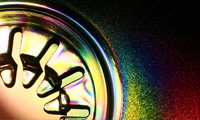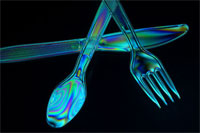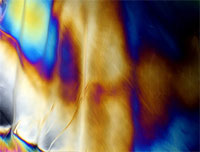
Geekery and science meets photography: Cross-polarization is a fantastic little technique that exploits a quirk in the way polarizers work.
Think of light as wooden ice-cream sticks that are flying towards a set of bars. The bars will only let the sticks that happen to be aligned with the bars through, and absorbs all the other sticks. Before the filter, the light is moving in lots of different polarizations. After it has passed through the filter, all the light is moving in the same linear polarization.
 Imagine now, if you will, what would happen if you were to put another set of bars, rotated 90 degrees in relation to the first set of bars. In theory, none of the ice-cream sticks would get through, right? Well, that’s how Polarizer filters work, too. Of course, no polarizer filter is perfect, so some light will always get through, but the vast bulk of light is filtered out.
Imagine now, if you will, what would happen if you were to put another set of bars, rotated 90 degrees in relation to the first set of bars. In theory, none of the ice-cream sticks would get through, right? Well, that’s how Polarizer filters work, too. Of course, no polarizer filter is perfect, so some light will always get through, but the vast bulk of light is filtered out.
 Cross-polarization exploits this by placing objects made of some types of plastic between the first and the second polarizer. For this particular set-up, you’ll want to put your first polarizer in front of the light source, then your plastic object, and then use the second polarizer in front of your lens.
Cross-polarization exploits this by placing objects made of some types of plastic between the first and the second polarizer. For this particular set-up, you’ll want to put your first polarizer in front of the light source, then your plastic object, and then use the second polarizer in front of your lens.
The effect that can be seen when cross-polarizing light is startling. Chances are that you’ve seen cross-polarized images before, and thought that they were digital image manipulations or done with really advanced lighting. The opposite is true: Due to the manufacturing process used in creating injection-moulded clear plastics, the plastic takes on some ability to polarize light itself. When the polarized light passes through these plastics, then, their phase gets altered. By filtering out all other light with the second polarizer, you get the colorful, acid-flashback-style images.
 You can buy sheets of polarization film from most photographic outlet – all you need to do is to cut off a piece that is big enough to cover your light source, and another piece that is of a size of the right size to stick in front of your camera lens. Then, the hunt starts for finding the most interesting types of plastic to start playing with…
You can buy sheets of polarization film from most photographic outlet – all you need to do is to cut off a piece that is big enough to cover your light source, and another piece that is of a size of the right size to stick in front of your camera lens. Then, the hunt starts for finding the most interesting types of plastic to start playing with…
Photos in this post were found by searching for Cross Polarization (or Cross Polarisation) on Flickr. The cutlery image is by Elyssa, the mad colours image is by Geartron, and the CD cover insert is by _maverick_.
Do you enjoy a smattering of random photography links? Well, squire, I welcome thee to join me on Twitter - Follow @Photocritic
© Kamps Consulting Ltd. This article is licenced for use on Pixiq only. Please do not reproduce wholly or in part without a license. More info.





